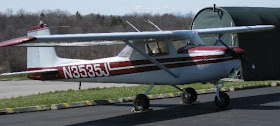This is a Cessna 150.

Generations of pilots learned to fly in them; I did much of my private pilot training in ones that were about this vintage. They were tough airplanes that took a lot of abuse, but as long as they were rigged correctly (or even close enough), they were and are honest airplanes to fly. You won't go anywhere fast in one, but if you don't mind loping along at 95mph or so on 4 gallons of gas an hour, they will get you there.
I think this is a Grumman Tiger.

For a four-place, fixed-gear, fixed prop aircraft, they were pretty fast. A clean one should cruise close to 160mph at higher power settings. If you wanted to fly that fast in a fixed-gear Cessna, you had to buy a 182 and do it with 50 more horsepower (and more gas).
This is a retractable gear Cessna 172.

The model name was the "Cutlass", which gave rise to the moniker the "Gutless Cutlass." It had the same displacement as the Grumman Tiger, but it had a constant-speed (controllable-pitch) prop. Between that and the retractable gear, it might keep pace with a Grumman Tiger.
The Cessna gear retraction system was a marvel to watch and, at times, a nightmare. The main gear legs would lift off from the mounts, turn 90 degrees and then retract to the rear. The retraction sequence added enough drag that wise pilots left the gear down until they had gained some altitude and speed. It worked well if the owner didn't skimp on the maintenance and if the mechanic understood it. If not, then it could be very expensive to fix.
The early Cessna 210s had doors which fully covered the main gear once retracted. The doors closed over the gear wells when the gear was down, too, so that in the retraction and lowering sequences, the doors would open, the gear moved, and the doors then closed again. The doors themselves could be a real headache and there were approved modifications to remove them.
A drawback of the Cutlass was that it did not meet the FAA's requirements for a "high performance" aircraft. You could get your retractable gear sign-off in a Cutlass, but not "high-performance", as a "high performance" aircraft had retractable gear, flaps, a controllable-pitch prop and an engine that produced at least 200 HP. So if you wanted that sign-off in your logbook, you had to find a flight school with a 182 RG, a Piper Arrow, a Beechcraft Sierra or a North American Navion.
I went with the Navion.

It was a much cooler airplane to fly.
The Navion looks like a small, two seat version of a WWII fighter.
ReplyDeleteZippy looking thing.
Way cool!
They are four-seaters.
ReplyDeleteCool airplanes, to be sure, but I prefer to do my flying close to the ground (refer to the "Rendezvous" video you posted on Wednesday).
ReplyDelete